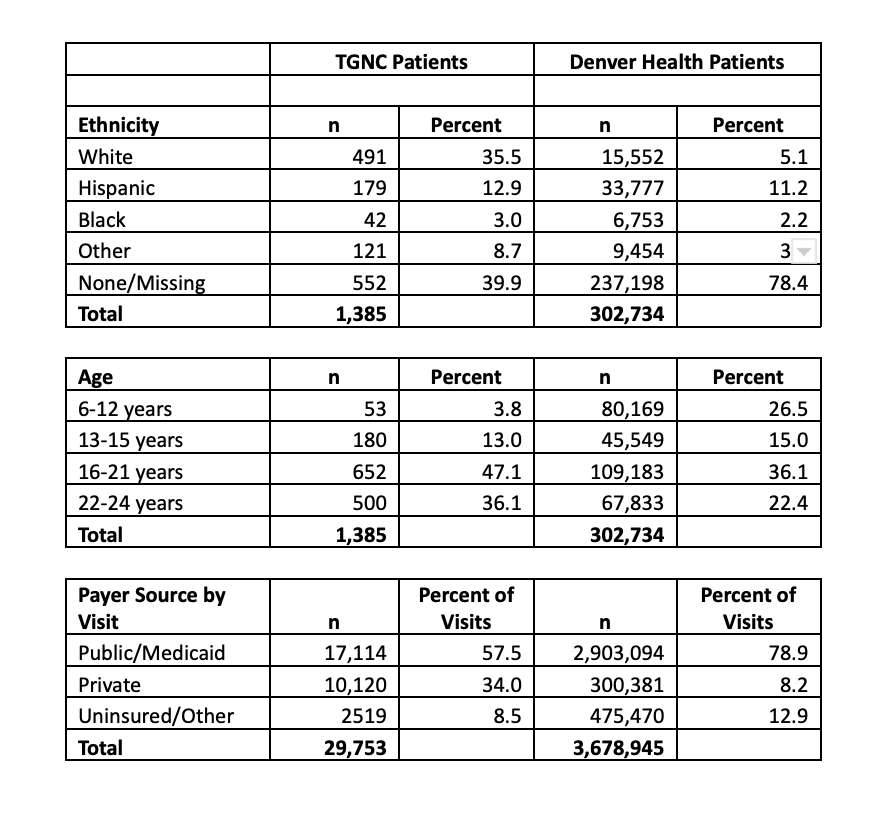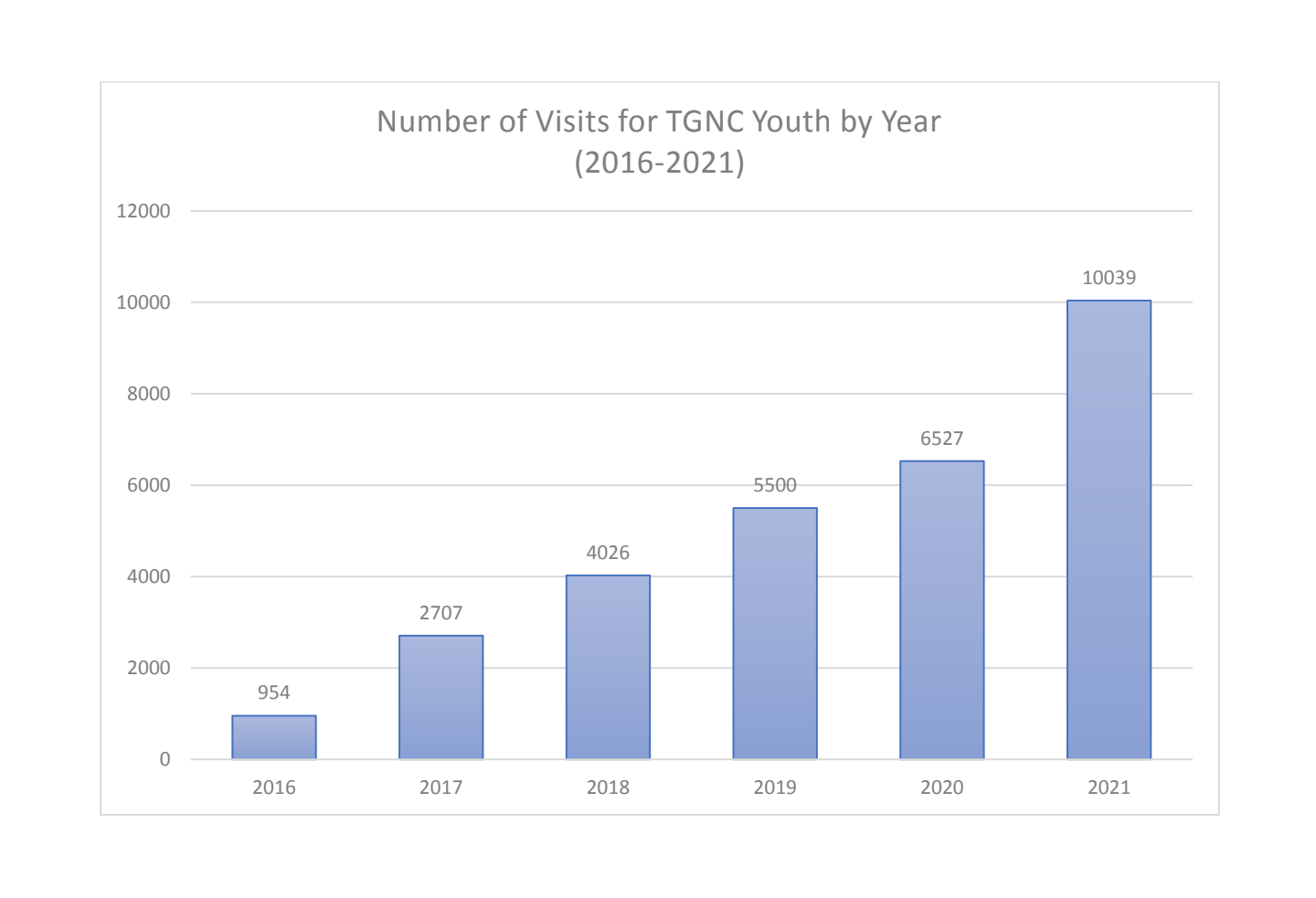Endocrinology: Transgender
Category: Abstract Submission
Endocrinology I
523 - Expanding Access to Gender-Affirming Care for Children and Adolescents with Gender Dysphoria In an Urban Safety Net System
Friday, April 22, 2022
6:15 PM - 8:45 PM US MT
Poster Number: 523
Publication Number: 523.107
Publication Number: 523.107
Anna-Lisa Munson, University of Colorado School of Medicine, Denver, CO, United States; Patricia A. Braun, University of Colorado School of Medicine | Denver Health, Denver, CO, United States; Kathryn Love-Osborne, University of Colorado School of Medicine, Denver, CO, United States
- AM
Anna-Lisa Munson, MD, MPH
Assistant Professor
University of Colorado School of Medicine
Denver, Colorado, United States
Presenting Author(s)
Background: The prevalence of gender dysphoria in children and adolescents has been estimated to be as high as 1.9%. Transgender and gender nonconforming (TGNC) youth are at much higher risk for poor mental and physical health, and have lower rates of access to healthcare than their cisgender peers. The COVID-19 pandemic has further limited their access to healthcare, as well as to social supports and mental healthcare. Gender-affirming care has typically occurred in specialty referral clinics under the auspices of endocrinology and adolescent medicine departments, which can be a barrier to accessing care.
Objective: To describe methods used to expand care to TGNC youth using a primary care model in an urban safety-net healthcare system.
Design/Methods: Retrospective observational study using data from the Denver Health (DH) electronic medical record (EMR), between 2016 - 2020. DH is an urban safety-net system providing care to 176,000 unique patients annually. Subjects were ages 6-24 years, attended an outpatient (in person or telehealth) visit at one of DH’s 17 clinics, and carried one or more diagnosis codes consistent with a diagnosis of gender dysphoria or transgender. DH developed a program in which primary care providers (PCPs) trained to become “transgender champions” in community-based clinics, and deliver gender-affirming care to youth. Care navigators directed patients to these providers. In addition, the expansion of telehealth during the COVID-19 pandemic has allowed DH to reach patients outside of the Denver metro area for care.
Results: During 2016-2020, there were 302,734 patients aged 6 to 24 years of which 0.5% identified as TGNC (n= 1,385). During this time, a total of 7 PCPs were trained in the delivery of gender-affirming care for TGNC youth. During this time, the number of visits for TGNC youth increased ten-fold (954 in 2016 to 10,039 in 2020). TGNC subjects were more likely to be white and have private insurance than our general patient population; however, 24.3% of TGNC patients seen were youth of color and a large proportion of visits were covered by Medicaid (57.3%) or were uninsured (8.5%).Conclusion(s): Through several low-cost measures, our urban safety-net hospital system was able to significantly expand gender-affirming care to underserved TGNC youth. Our findings support a model in which PCPs can provide quality gender affirming care to patients who may otherwise not have access. This model should be investigated in prospective studies, and general pediatricians should continue to screen for health risks and identify barriers to care for their TGNC patients.
Table 1: Patient Characteristics
Image 1: Number of Visits for TGNC Youth By Year (2016-2021)
Objective: To describe methods used to expand care to TGNC youth using a primary care model in an urban safety-net healthcare system.
Design/Methods: Retrospective observational study using data from the Denver Health (DH) electronic medical record (EMR), between 2016 - 2020. DH is an urban safety-net system providing care to 176,000 unique patients annually. Subjects were ages 6-24 years, attended an outpatient (in person or telehealth) visit at one of DH’s 17 clinics, and carried one or more diagnosis codes consistent with a diagnosis of gender dysphoria or transgender. DH developed a program in which primary care providers (PCPs) trained to become “transgender champions” in community-based clinics, and deliver gender-affirming care to youth. Care navigators directed patients to these providers. In addition, the expansion of telehealth during the COVID-19 pandemic has allowed DH to reach patients outside of the Denver metro area for care.
Results: During 2016-2020, there were 302,734 patients aged 6 to 24 years of which 0.5% identified as TGNC (n= 1,385). During this time, a total of 7 PCPs were trained in the delivery of gender-affirming care for TGNC youth. During this time, the number of visits for TGNC youth increased ten-fold (954 in 2016 to 10,039 in 2020). TGNC subjects were more likely to be white and have private insurance than our general patient population; however, 24.3% of TGNC patients seen were youth of color and a large proportion of visits were covered by Medicaid (57.3%) or were uninsured (8.5%).Conclusion(s): Through several low-cost measures, our urban safety-net hospital system was able to significantly expand gender-affirming care to underserved TGNC youth. Our findings support a model in which PCPs can provide quality gender affirming care to patients who may otherwise not have access. This model should be investigated in prospective studies, and general pediatricians should continue to screen for health risks and identify barriers to care for their TGNC patients.
Table 1: Patient Characteristics

Image 1: Number of Visits for TGNC Youth By Year (2016-2021)

